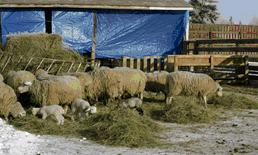| | Whether it’s melting snow, longer days, and new spring grass, or the drier, frosty days of fall the changing seasons in Alberta trigger changes in feeding chores for flock managers. Having a 365-day plan balances the nutritional needs of the flock with the feeds, forages and pastures available. Planning ahead not only makes life easier, it reduces wasted time, effort and feed dollars.
A 365 day feed plan is based on:
Good records.
- The number of ewes, lambs, rams to be fed plus the number of days of grazing and the days on stored feeds. Be sure to have extra feed to provide a safety margin just in case your plans and the weather don't agree.
- Good records mean you can identify poor performers and cull them. It costs as much to feed a poor ewe as a good one.
- Get the most out of your pastures with managed grazing systems incorporating rotational grazing, seeded annuals and stockpiled forages to extend the traditional grazing season. Central Alberta farm trials in the 1990’s were able to shift the traditional feeding period of 200 days to an extended grazing season of over 200 days.
Have the right quality of feed for the right sheep. Base a feed program on your flock nutritional needs not only on the feed you may happen have on hand.
- Forages are the basis of ruminant diets and make up the bulk of winter diets for sheep in Alberta. Sample and test forages annually. Know what nutrients are available, what nutrients are missing and what supplements will be needed.
- Develop rations to meet the needs of all the sheep in your flock. Different groups of sheep – mature ewes, yearlings, replacement ewe lambs, growing lambs and rams - have different nutritional requirements. Ewes in early pregnancy have dramatically different nutrient requirements than lactating ewes.
- Group sheep with the same nutritional needs together.
- Advice on developing rations is available from feed companies, industry consultants and the AgInfo Centre (310-FARM).
- SheepBytes Ration Balancer software was developed for lamb producers and their nutritional advisors to use to fine-tune feeding and manage feed costs. There is a free training video listed as a "Video Tutorial" on the header of the home page. The video has step-by-step instructions on how to use the program and makes a good reference. Try the free demo. Then subscribe to SheepBytes at www.sheepbytes.ca
Body condition score a few sheep in every group to monitor the effectiveness of the feeding plan.
- Knowing how to body condition score is critically important in managing a flock.
- A flock target should be that ewes breed to lamb in the first cycle. Ewes should come off pasture in good body condition. Any ewe not in a 3.0 or better body condition score (BCS) needs to be carefully assessed. Does she need deworming? Did she wean three lambs and needs more feed? Are her teeth and feet sound? Is it time she was culled?
- Yearling ewes who do a good job of weaning their first lambs often take 6 weeks of flushing, rather than the normal 2 to 3 weeks, to reach a 3.0 to 3.5 BCS.
- Ewe lambs need to be fed separately if you expect them to continue to grow, get pregnant, give birth to and wean strong, healthy lambs.
- As handling and weighing systems are improved it's becoming easier for producers to track gains or losses in bodyweight. Knowing animal weight is important in managing flock nutrition.
Have enough feed. Don’t run short of good alfalfa hay when your ewes are in the first three weeks of lactation. Have enough lamb rations to get through the weaning and finishing periods without adding stress from changes in palatability and intake to rumen upsets due to changes in rations.

Reduce feed waste and monitor intake. Feeding too little or too much is costly. Good feeders, suited to the class of sheep using them, minimize feed waste.
Get more out of harvested feeds. Hay is costly whether you’ve struggled to get your own put up dry or whether you buy it all. Protect hay from weathering by storing in barns, sheds or properly installed tarps. Newer hay tarps made of breathable materials allow moisture to escape, reducing heating and mould damage. They are also more ultra-violet light stable lasting longer than old plastic tarps offsetting higher cost. Think about where you locate feed: is it close to where it will be fed, can it be accessed after snowstorms, will mud be a problem.
Look at your pastures and flock grazing history. Good grazing management is a complicated juggle of plants, animals and weather. It’s different every year. Running out of pasture as flushing starts or as lambs are growing is costly. Managed grazing focuses on improving soils, plants, and animal production. More information about managed grazing has been developed for Alberta flocks owners in the Managed Grazing Producer Resource Module and Advanced Grazing fact sheets on www.ablamb.ca. There are also grazing videos on Youtube’s sheepcentralalberta.
Have a back-up plan. Know how you will feed your sheep if the unexpected occurs:
if rains are short and pastures dry up,
if spring is cold and you need to feed another month before the grass is ready,
if winter is colder than usual and your flock needs more feed than you have on hand,
if feed costs unexpectedly increase or local shortages occur. |
|